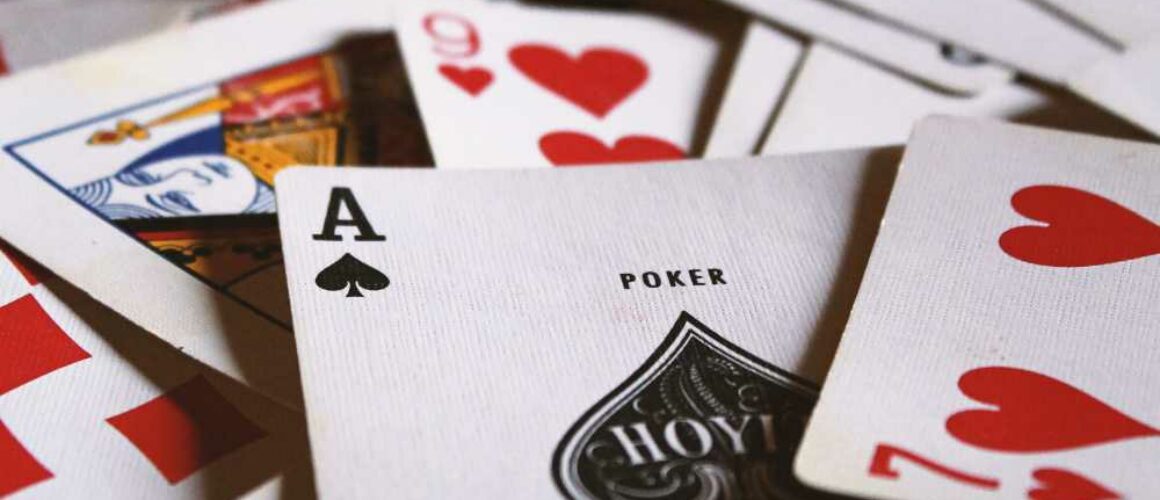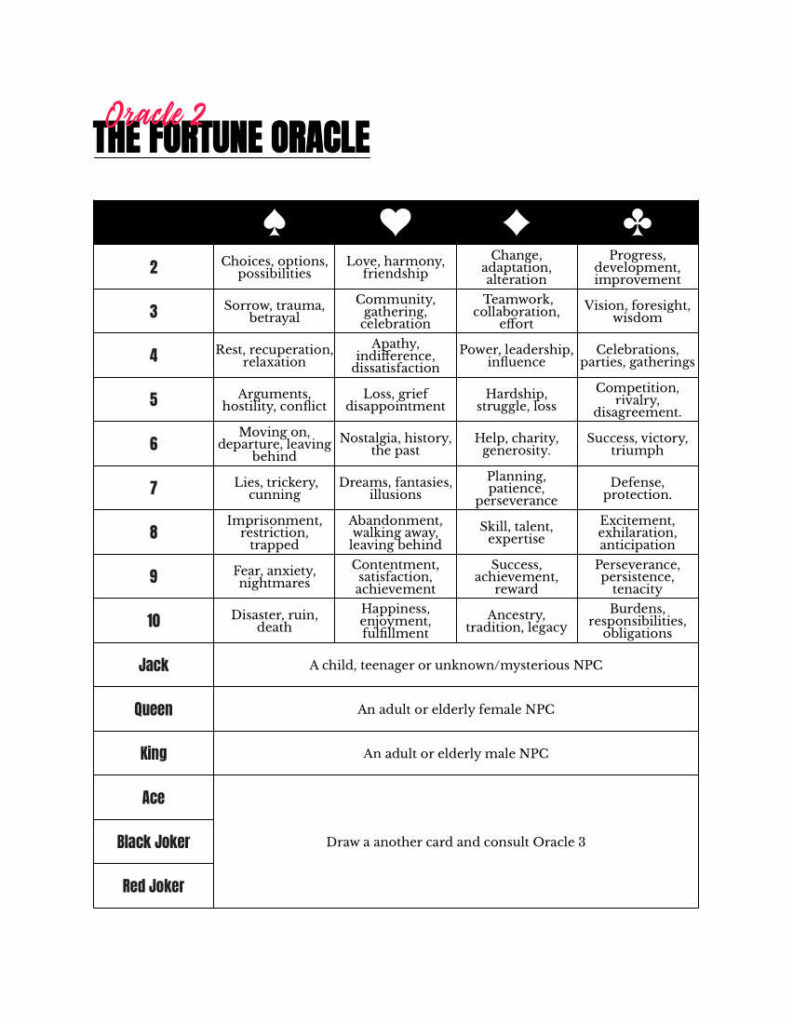The Random Event Oracle: How to introduce random events
The Random Event Oracle introduces unanticipated scenes into your game. Whenever you use the Fortune Oracle and draw an Ace or Joker, a random event enters the scene. This introduces variety and unexpected twists into your adventure. The oracle consists of phrases that describe commonly occurring story motifs that can become a part of your adventure. This tool forms part of the Solo Gaming Tool.
When a random event enters your game through the Fortune Oracle, draw a card and look at the story motif associated with it. Improvise a scene based on the motif and introduce it into your game.
The Random Event Oracle was inspired by The Adventure Crafter by Wordmill Games.

To help you create your scenes, I included a scene idea with each card to help guide you. Use the logic of your story and setting when applying the random event to your adventure.
Spades
2 of Spades
Event: A mysterious event
Scene idea: Something strange or out of the ordinary is happening or has happened.
3 of Spades
Event: A necessary resource runs out
Scene idea: A resource that’s necessary to a character or group of characters has run out.
4 of Spades
Event: Impending doom
Scene idea: A character or group of characters will meet their doom.
5 of Spades
Event: Shady dealings
Scene idea: A character is engaging in criminal or otherwise suspicious dealings.
6 of Spades
Event: An ambush
Scene idea: A character is being ambushed or is ambushing another character.
7of Spades
Event: An abduction
Scene idea: An abduction or attempted abduction is taking place.
8 of Spades
Event: A work-related gathering
Scene idea: A gathering of workers or employees
9 of Spades
Event: A figure from the past
Scene idea: A figure from the past appears. This can range from a person in a character’s personal past to a historical figure from a nation’s past.
10 of Spades
Event: An unfortunate event
Scene idea: Something unfortunate happens to a character. This can also mean an unfortunate event from the past.
Jack of Spades
Event: A problem returns
Scene idea: A problem from the past returns. This can range from a personal problem to a problem on a large scale.
Queen of Spades
Event: A savior
Scene idea: A savior has entered the scene or a character needs a savior.
King of Spades
Event: Official business
Scene idea: A character is on official business. This includes all government officials.
Ace of Spades
Event: A mysterious item
Scene idea: A mysterious item is the focus of the scene. This can be any strange or unknown item.
Hearts
2 of Hearts
Event: Religion
Scene idea: Religion or religious figures form the central theme of the scene.
3 of Hearts
Event: The need to hide
Scene idea: Characters need or try to hide.
4 of Hearts
Event: Conflict
Scene idea: A character is engaging in conflict with another. This can range from a simple verbal disagreement to an outright fight.
5 of Hearts
Event: Escort duty
Scene idea: A scene where a character needs or is performing escort duty.
6 of Hearts
Event: A just cause gone wrong
Scene idea: Something that is righteous or just has negative consequences.
7 of Hearts
Event: A confrontation
Scene idea: Characters are confronted either literally or figuratively. This can range from being confronted by enemies to confronting injustice in a community.
8 of Hearts
Event: Destruction
Scene idea: A character, object, or anything else is destroyed. The destruction can range from relatively mild to outright desolation.
9 of Hearts
Event: A character disappears
Scene idea: A missing person forms the focus of the scene. This can range from a missing stranger to an important friend or associate.
10 of Hearts
Event: A rare or unique gathering
Scene idea: A gathering is taking place that’s rare or unique.
Jack of Hearts
Event: Someone is where they shouldn’t be
Scene idea: A character is somewhere they don’t belong.
Queen of Hearts
Event: Useful information from an unknown source
Scene idea: An unknown source provides useful information to a character.
King of Hearts
Event: An influential person
Scene idea: An influential person has entered the scene. This person can be an influential leader or an influential artist or expert.
Ace of Hearts
Event: A scapegoat
Scene idea: A character is used as a scapegoat for a misdeed.
Diamonds
2 of Diamonds
Event: Death
Scene idea: A scene of death. This includes funerals, victims of crime, or any other form of death.
3 of Diamonds
Event: A group is in trouble
Scene idea: A group of characters is in trouble. This can range from a group of single individuals to large organizations.
4 of Diamonds
Event: Help, for a price
Scene idea: A character provides or asks for help, for a price.
5 of Diamonds
Event: Injustice
Scene idea: A character is experiencing an injustice.
6 of Diamonds
Event: A standoff
Scene idea: A standoff is taking place between characters.
7 of Diamonds
Event: Theft
Scene idea: A character is committing theft or theft has taken place.
8 of Diamonds
Event: Followed
Scene idea: A character is being followed.
9 of Diamonds
Event: Meeting friends
Scene idea: A character meets friends or allies.
10 of Diamonds
Event: Asking for help
Scene idea: A character asks for help.
Jack of Diamonds
Event: A mysterious new person
Scene idea: A mysterious new character is the focus of the scene.
Queen of Diamonds
Event: Fraud and deception
Scene idea: A character is committing fraud or deceiving another character.
King of Diamonds
Event: An argument
Scene idea: An argument is taking place between two or more characters.
Ace of Diamonds
Event: An emotional gathering Scene idea: Characters are engaging in an emotional gathering. This can range from joyous gatherings to mob violence.





